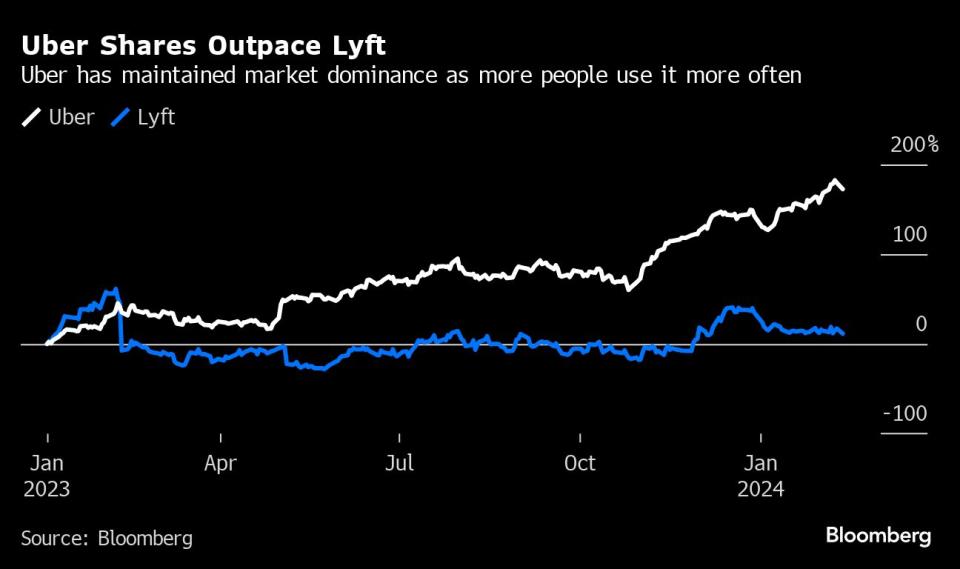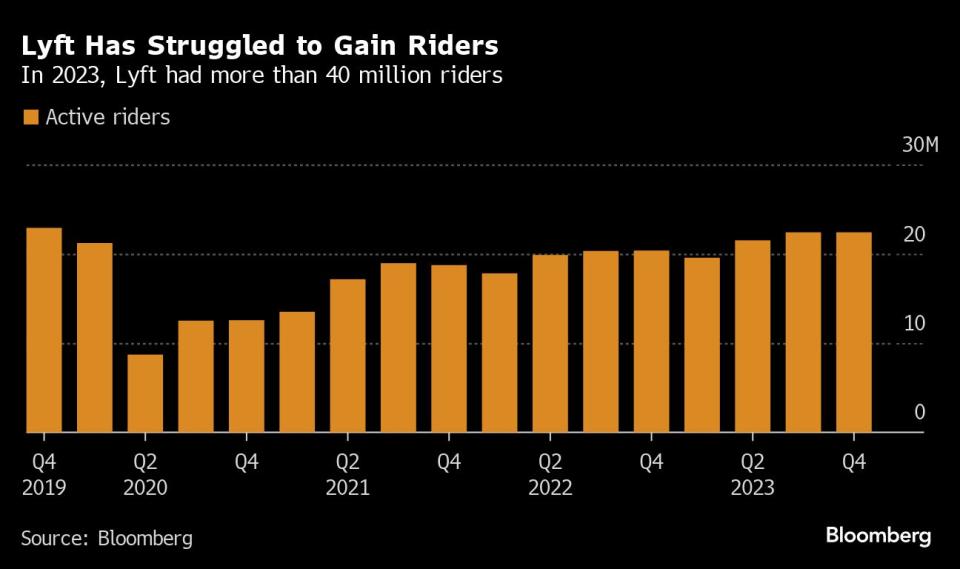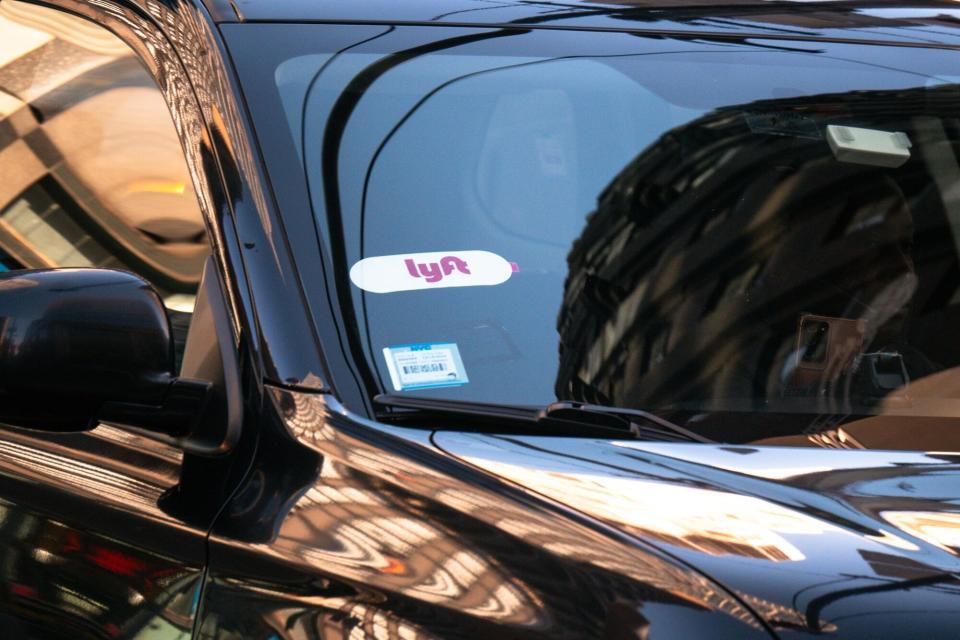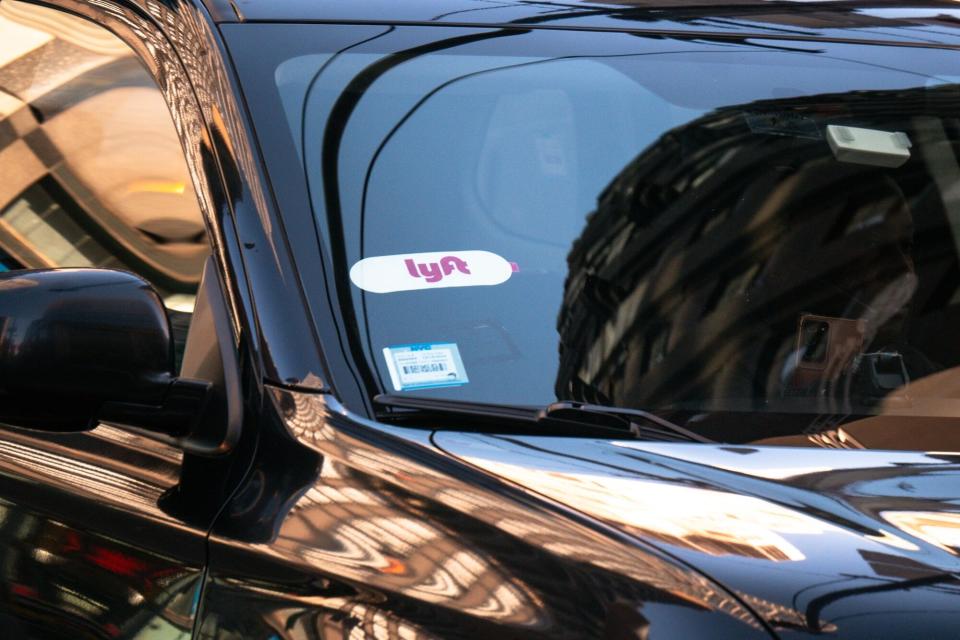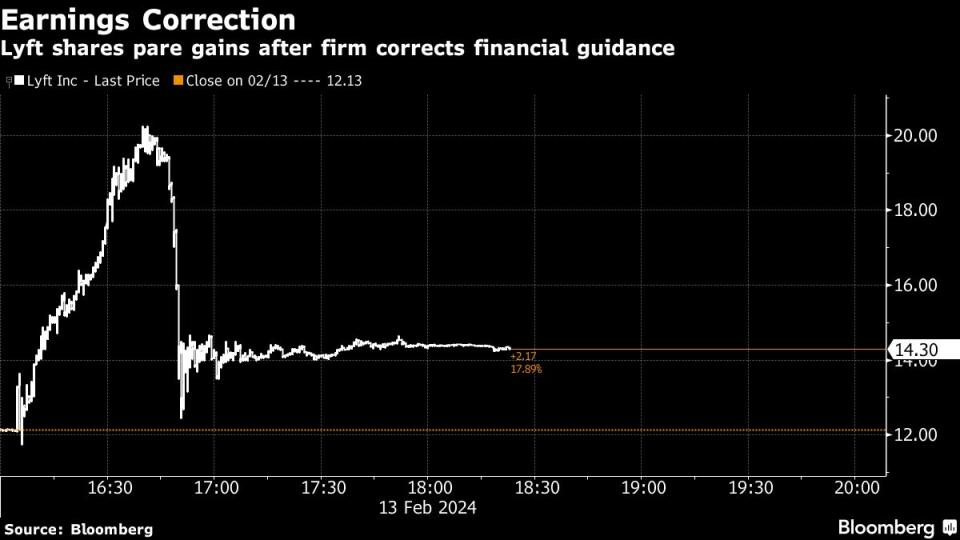A ‘Clerical Error’ in Lyft Outlook Triggered 67% Jump
(Bloomberg) -- It was, without a doubt, a strong earnings report.
Most Read from Bloomberg
Trump Keeps NY Empire Intact as Judge Rescinds Asset-Sale Order
Record US Stock Rally Is Under Threat From a World in Turmoil
Systemic Risk Concerns Grow Among Money Managers as Real Estate Woes Cause Turmoil
Wall Street’s Moelis Bet Big on the Middle East. Now He’s Cashing In
Lyft Inc. projected adjusted earnings as much as 11% higher than analysts’ estimates, and reported bookings ahead of expectations. And then there was the outlook for profitability: Margins, the ride-hailing provider said in an initial press release Tuesday, were set to expand this year by an eye-watering 500 basis points. Shares surged, jumping 67% in after-hours trading.
But the projection was off. Way off.
Less than an hour after issuing the statement, Lyft Chief Financial Officer Erin Brewer joined a call with analysts and said the company is actually expecting adjusted earnings margins, calculated as a percentage of bookings, to expand by 50 basis points — not 500 — acknowledging, when asked by an analyst, that the press release was incorrect. A company spokesperson later attributed the mistake to a “clerical error,” and the company eventually corrected its statement and regulatory filings.
Shares almost immediately gave up some of those gains. But the stock was still up as much as 38% on Wednesday in New York, the biggest intraday gain ever and hitting its highest point in a year.
It’s a “black-eye moment” for Lyft, said Dan Ives, an analyst at Wedbush Securities, “a debacle of epic proportions.” He said by email that he’d “never seen an error like this in my almost 25 years on the Street.”
The mistake overshadowed what was otherwise a solid beat on profit and bookings projections that signaled a years-long effort to boost ridership and challenge Uber Technologies Inc. may be paying off.
In fact, both Lyft and Uber delivered strong earnings reports this quarter, suggesting continued growth in overall rider demand since a nationwide plunge during the pandemic. The two have spent fiercely to recruit and retain enough drivers to meet the rise in orders. Lyft Chief Executive Officer David Risher, who took the helm less than a year ago, has focused the operations on customer satisfaction and has emphasized a return to the basics in an effort to close the gap with Uber. Lyft has spent millions of dollars to lure drivers but has had a hard time boosting its rider base.
“Lyft clearly did one thing right – it corrected the error quickly and decisively,” said Brad Foster, a partner specializing in securities litigation at corporate law firm Haynes Boone. “The reality is that people make mistakes, and mistakes are not securities fraud.”
Gross Bookings
Under Risher, Lyft has cut hundreds of jobs since late 2022 as part of a restructuring, including positions in corporate communications, policy and employee operations.
In the fourth quarter, Lyft said gross bookings jumped 17% from a year earlier to $3.72 billion, ahead of estimates for $3.67 billion. Revenue was $1.22 billion, up 4% from a year earlier and in line with projections. And it projected adjusted earnings of as much as $55 million in the first three months of the year, topping analysts’ estimates of $49.5 million.
Lyft said the number of active riders on its platform increased 10% in the fourth quarter from a year earlier to 22.4 million. Last year, Lyft had more than 40 million riders, the highest annual ridership in its history.
“We’ve entered 2024 with a lot of momentum and a clear focus on operational excellence,” CFO Brewer said, positioning the company to “drive meaningful margin expansion and our first full-year of positive free cash flow.”
But Lyft still lags behind Uber. According to market research firm YipitData, the company has held around 30% of the US rideshare market compared with 70% for Uber since the second quarter of 2022. Last week, Uber reported its full year of profit as a public company and said trips rose 24% in the quarter to 2.6 billion.
Stabilizing its market share is a critical first step for Lyft in building investors’ confidence “in the long-term story,” analysts at Jefferies Financial Group wrote before the company’s results were released.
Lyft said adjusted earnings before interest, tax, depreciation and amortization were $66.6 million in the fourth quarter, beating the $56 million estimated by analysts. It reported a net loss of $26.3 million.
Lyft has been making efforts to recruit more drivers and riders to its platform. One project that’s gained traction is the Women+ Connect program, which matches women and non-binary drivers and riders. Since the initiative’s launch in September, 67% of eligible drivers have opted in and kept the feature on 99% of the time, Lyft said.
The company launched in-app video ads in the fourth quarter, and its media revenue in that period exceeded the level achieved in all of 2022, it said, without giving an exact amount.
And, like many areas of the US economy, Lyft also saw a Taylor Swift bump. High-attendance stadium events such as concerts by Swift and Beyonce, the US Open and football games helped boost rides by 35%, Lyft said.
As part of efforts to retain drivers and promote pay transparency, Lyft earlier this month said drivers will earn at least 70% of the amount that riders pay each week, excluding external fees.
But workers say it doesn’t go far enough. Drivers for Uber and Lyft are preparing to strike on Valentine’s Day on Wednesday, to call attention to low pay and what they claim is poor treatment by the app companies, according to a coalition representing drivers.
Both Uber and Lyft drivers are considered independent contractors rather than employees, which has driven criticism from states such as New York, Massachusetts and California. Last November, both companies agreed to pay New York drivers a total of $328 million to prevent further litigation over whether drivers should be classified as employees with traditional legal protections.
--With assistance from Natalie Lung and Bailey Lipschultz.
(Updates to add earlier job cuts and updates shares. A previous version of the story corrected the spelling of Jefferies Financial Group)
Most Read from Bloomberg Businessweek
How Paramount Became a Cautionary Tale of the Streaming Wars
‘Playing God’: This Labor Activist’s Relentless Emails Force Companies to Change
?2024 Bloomberg L.P.
